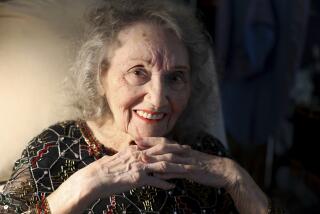Gladys Ahern; Vaudeville Singer and Dancer
- Share via
Gladys Ahern, who with her husband brought song and laughter to thousands of Americans during the heyday of vaudeville and a brief respite from battle to thousands more GIs during World War II, is dead, it was learned this week.
Robert Dwan, who writes regularly on the show business stars of the past, said Ahern was believed to be in her late 80s when she died June 12 in a Burbank hospital.
Will and Gladys Ahern provided a potpourri of entertainment unique even in vaudeville, where contortionists and mind readers vied with classical singers and ribald comedians for a headline spot on several U.S. theatrical circuits.
She was a dancer and a beauty who wore what in the 1920s were considered scanty costumes. He was a comic in cowboy garb who twirled a rope in the Will Rogers style while keeping up a steady stream of jokes. As he twirled a lariat, his wife stepped inside the spinning rope while singing “Alice Blue Gown” in a Latin accent.
Trying to explain the success of that perplexing behavior, Dwan, in a 1983 article in The Times, wrote that “their genius was in making these diverse numbers come together in a cohesive act.”
In 1919, Gladys Reese met the man who was to become her husband when he was playing at a speak-easy in Chicago and she was dancing in the chorus.
In 1927, they joined the Broadway show “Sidewalks of New York,” quickly became vaudeville headliners and toured Europe, where Will Ahern learned enough German and French to make the jokes understandable.
They appeared in some Vitaphone short subjects in the early days of sound films and in the 1929 feature film “Hold Everything,” with Joe E. Brown. The Aherns were successful during the Depression (she turned down a film contract from Cecil B. De Mille that was $1,000 a week less than she was earning) and returned to Europe in 1938.
They fled the continent after the Nazi invasion of Poland and France and after the bombing of Pearl Harbor began extensive tours of U.S. bases overseas under the aegis of the USO. After the war they settled in Hollywood, establishing the Rainbow Studio, a dance and drama studio they operated jointly until Will Ahern’s death in 1983.
More to Read
The biggest entertainment stories
Get our big stories about Hollywood, film, television, music, arts, culture and more right in your inbox as soon as they publish.
You may occasionally receive promotional content from the Los Angeles Times.










